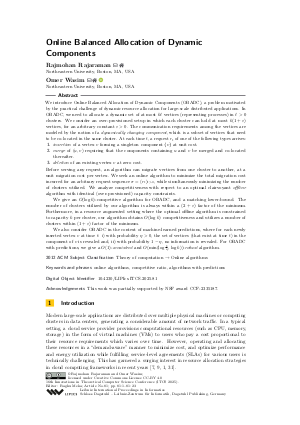LIPIcs.ITCS.2025.81.pdf
- Filesize: 0.88 MB
- 23 pages

 Creative Commons Attribution 4.0 International license
Creative Commons Attribution 4.0 International license

We introduce Online Balanced Allocation of Dynamic Components (OBADC), a problem motivated by the practical challenge of dynamic resource allocation for large-scale distributed applications. In OBADC, we need to allocate a dynamic set of at most k𝓁 vertices (representing processes) in 𝓁 > 0 clusters. We consider an over-provisioned setup in which each cluster can hold at most k(1+ε) vertices, for an arbitrary constant ε > 0. The communication requirements among the vertices are modeled by the notion of a dynamically changing component, which is a subset of vertices that need to be co-located in the same cluster. At each time t, a request r_t of one of the following types arrives:
1) insertion of a vertex v forming a singleton component v at unit cost.
2) merge of (u,v) requiring that the components containing u and v be merged and co-located thereafter.
3) deletion of an existing vertex v at zero cost. Before serving any request, an algorithm can migrate vertices from one cluster to another, at a unit migration cost per vertex. We seek an online algorithm to minimize the total migration cost incurred for an arbitrary request sequence σ = (r_t)_{t > 0}, while simultaneously minimizing the number of clusters utilized. We analyze competitiveness with respect to an optimal clairvoyant offline algorithm with identical (over-provisioned) capacity constraints.
We give an O(log k)-competitive algorithm for OBADC, and a matching lower-bound. The number of clusters utilized by our algorithm is always within a (2+ε) factor of the minimum. Furthermore, in a resource augmented setting where the optimal offline algorithm is constrained to capacity k per cluster, our algorithm obtains O(log k) competitiveness and utilizes a number of clusters within (1+ε) factor of the minimum.
We also consider OBADC in the context of machine-learned predictions, where for each newly inserted vertex v at time t: i) with probability η > 0, the set of vertices (that exist at time t) in the component of v is revealed and, ii) with probability 1-η, no information is revealed. For OBADC with predictions, we give a O(1)-consistent and O(min(log 1/(η), log k))-robust algorithm.








Feedback for Dagstuhl Publishing